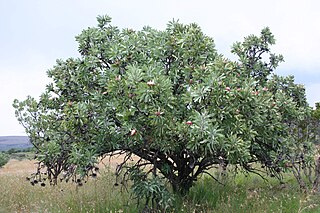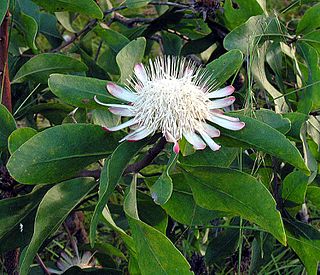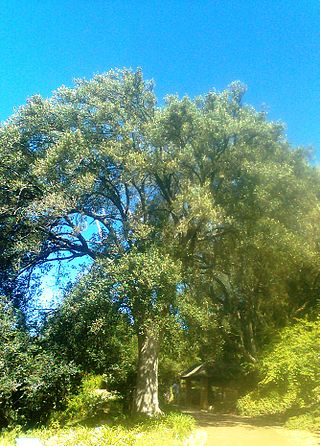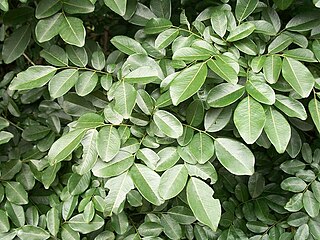
Euclea, from the Greek eukleia meaning "glory and fame", denotes a group of flowering plants in the Ebenaceae or ebony family. They were described as a genus by Linnaeus in 1774. The genus includes evergreen trees and shrubs, native to Africa, the Comoro Islands and Arabia. Several species are used for timber, producing a hard, dark heartwood timber similar to ebony.

Protea caffra, native to South Africa, is a small tree or shrub which occurs in open or wooded grassland, usually on rocky ridges. Its leaves are leathery and hairless. The flower head is solitary or in clusters of 3 or 4 with the involucral bracts a pale red, pink or cream colour. The fruit is a densely hairy nut. The species is highly variable and has several subspecies.

Protea angolensis is also known as the Angolan protea, northern protea or northern sugarbush. In Afrikaans it is known as the noordelijke suikerbos. This is a dwarf, multistemmed shrub or small straggling tree occurring in open wooded grassland and miombo.

Protea gaguedi is a species of tree which belongs to the genus Protea.

Ochna pulchra, also known as Lekkerbreek, is a small deciduous southern African tree up to 5 m, commonly found on deep sandy soil and rocky slopes, and belonging to the tropical family of Ochnaceae, which is widespread in Asia and Africa.

Kiggelaria africana is a large, robust, low-branching African tree, and is currently the only accepted species in the genus Kiggelaria.

Dalbergia obovata is a robust shrub or climber in the family Fabaceae, and is native to Southern Africa.

Croton gratissimus, is a tropical African shrub or small tree with corky bark, growing to 8 m and belonging to the family of Euphorbiaceae or spurges. Young twigs are slender and angular and covered in silver and rust-coloured scales.

Pappea capensis is a South African tree in the family Sapindaceae. It is the only species in the genus Pappea.

Combretum kraussii, the forest bushwillow, is a medium-sized to large tree of eastern South Africa, Eswatini and southern Mozambique, which is found within, or in the vicinity of forests. The specific name commemorates Dr. F. Krauss who undertook a collecting trip to South Africa from 1838 to 1840.

Erianthemum dregei is a species of parasitic plant in the family Loranthaceae, and is commonly known as the hairy mistletoe or wood flower.

Bauhinia galpinii is a species of shrub in the family Fabaceae. It is endemic to parts of eastern and southern Africa, where its popular name is "pride of De Kaap". In other places however, it is variously known as orchid tree, red bauhinia, nasturtium bauhinia, African Plume, red orchid bush, and by other informal names. The species name commemorates E. E. Galpin, a South African botanist and banker. Its common names include South African orchid bush, red bauhinia and Nasturtium bush.

Senegalia ataxacantha, commonly known as the flame thorn, is an African tree species with conspicuous red pods and numerous hooked prickles.

Erythrina zeyheri, commonly known as the ploughbreaker, is a deciduous, geoxylic subshrub and member of the Fabaceae, which is endemic to southern Africa. It grows no more than 60 cm tall and occurs naturally in the higher elevation grasslands of South Africa's central plateau, and that of adjacent Lesotho. They favour deep clay soil in the vicinity of creeks and marshes, and often form colonies. Its specific name commemorates the 19th century botanist, Karl Zeyher.

Ficus ingens, the red-leaved fig, is a fig species with an extensive range in the subtropical to dry tropical regions of Africa and southern Arabia. Despite its specific name, which means "huge", or "vast", it is usually a shrub or tree of modest proportions. It is a fig of variable habit depending on the local climate and substrate, typically a stunted subshrub on elevated rocky ridges, or potentially a large tree on warmer plains and lowlands. In 1829 the missionary Robert Moffat found a rare giant specimen, into which seventeen thatch huts of a native tribe were placed, so as to be out of reach of lions.

Dalbergia armata is a scrambling, deciduous species of legume that is native to subtropical to temperate regions of southeastern Africa. The robust, woody liana or small tree is armed with strong spines on the main stem and branches. It occurs sparsely or commonly in forest, bush, riparian fringes and in wooded ravines. It is sometimes employed as a bonsai subject, and it can be propagated from either seed or cuttings.

Protorhus longifolia, the red beech, is a medium to large, mostly dioecious species of tree in the family Anacardiaceae. It is native to South Africa and Eswatini, where it occurs in well-watered situations from coastal elevations to 1,250 m. The leafy, evergreen trees have rounded crowns and usually grow between 6 and 10 m tall, but regularly taller in forest.

Trichocladus ellipticus is a species in the genus Trichocladus, in the family Hamamelidaceae. It is also called white witch-hazel.
Osyris daruma is a species of plant in the family Santalaceae.

Boscia foetida, commonly known as the stink shepherd's tree and the smelly shepherd's bush, is an evergreen shrub or tree that is native to the warmer and drier parts southern Africa. It is found in semi-desert and arid bushveld, and in the west it occurs commonly in areas which are otherwise sparsely wooded. It is known for the particularly unpleasant smell of its flowers which appear during early spring, to which its specific name foetida alludes. Its freshly cut wood likewise has an unpleasant smell, and has traditional medicinal and magical uses, for instance as a protection against lightning. In central Botswana the village of Mopipi is named after this species.























